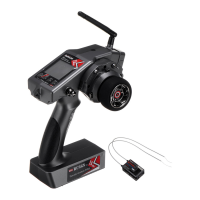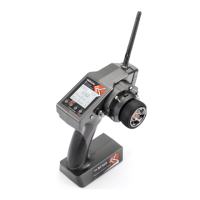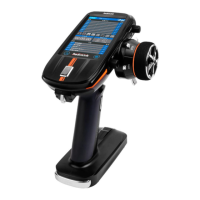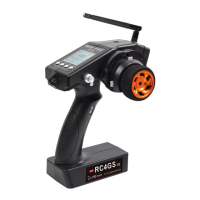27
GOAL of EXAMPLE: STEPS: INPUTS:
Reverse the direction of the elevator
servo.
Open
REVERSE
function.
for 1 second.
(If
ADVANCE
, again.)
to
REVERSE
.
Choose proper channel and set
direction. (Ex:
ELE REV
)
to
ELE
.
to
REV
. for 1 second.
Close.
Where next? Adjust servo travel with
END POINT
: see p. 27.
6HWXSGXDOWULSOHUDWHVDQGH[SRQHQWLDO
D/R
,
EXP
): see p. 30.
6HWXSÀLJKWWLPHUVVHHS
Set up trainer functions: see p. 34.
Except with CCPM helicopters, always complete your servo reversing prior to
any other programming. If you use pre-built
ACRO
GLID
functions that control
multiple servos, such as
FLAPERON
or
V-TAIL
, it may be confusing to tell whether
the servo needs to be reversed or a setting in the function needs to be reversed.
See the instructions for each specialized function for further details.
Always check servo direction prior to every flight as an additional
SUHFDXWLRQWRFRQ¿UPSURSHUPRGHOPHPRU\KRRNXSVDQGUDGLRIXQFWLRQ
NOTE:
THR-REV
is a special function that reverses the entire throttle control, including moving the trim functionality to
the Stick’s upper half. To use
THR-REV
, turn off the transmitter, hold down the MODE and END keys, turn on. CURSOR
DOWN to
THR-REV
and turn the DIAL to
REV
. Turn the transmitter off and back on. This change affects all models in the
radio.
End Point of servo travel adjustment (
END POINT
, also called EPA): the most flexible version of travel adjustment
available. It independently adjusts each end of each individual servo’s travel, rather than one setting for the servo that
affects both directions. Again, for CCPM helicopters, be sure to see
SWASH AFR
(see p. 73) prior to adjusting end points.
Adjustability:
• Can set each direction independently.
• Ranges from 0% (no servo movement at all) to 140%. At a 100% setting, the
throw of the servo is approximately 40° for channels 1-4 and approximately 55
° for channels 5-8.
• Reducing the percentage settings reduces the total servo throw in that direction.
Examples:
• Adjust the throttle high end to avoid binding at the carburetor, and low end to allow for proper carburetor closure.
$GMXVWÀDSVRXSWUDYHOLVRQO\VXI¿FLHQWIRUVWUDLJKWDQGOHYHOÀLJKWWULPPLQJZLWKIXOOGRZQWUDYHO
•
END POINT
PD\EHDGMXVWHGWRWRNHHSDVHUYRIURPPRYLQJRQHGLUHFWLRQVXFKDVÀDSVQRWLQWHQGHGWRDOVRRSHUDWHDV
spoilers.
• Retract servos are not proportional. Changing
END POINT
will not adjust the servo.
END POINT
adjusts only the individual servo. It will have no effect on any other servo that is operated in conjunction with
this servo via mix or preset programming such as
FLAPERON
,
AILEVATOR
, etc. This is so that each individual servo can be
FDUHIXOO\¿QHWXQHGWRDYRLGELQGLQJDQGRWKHUFRQÀLFWV7RDGMXVWWKHWRWDOWUDYHORIDIXQFWLRQVXFKDV
FLAPERON
, make
the adjustments in that function's controls. For CCPM helicopters, adjust the total travel of the function, such as collective
pitch, in
SWASH AFR
.
33.
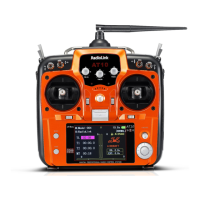
